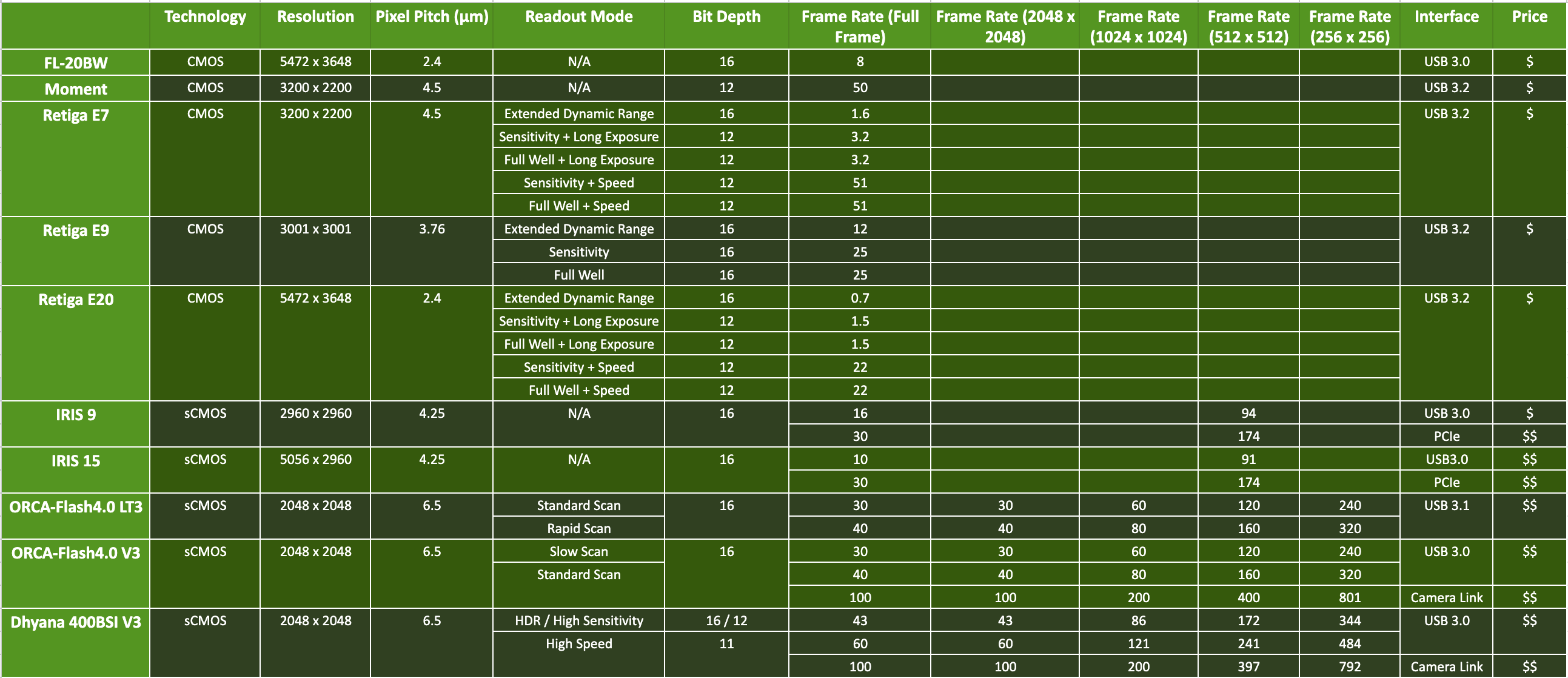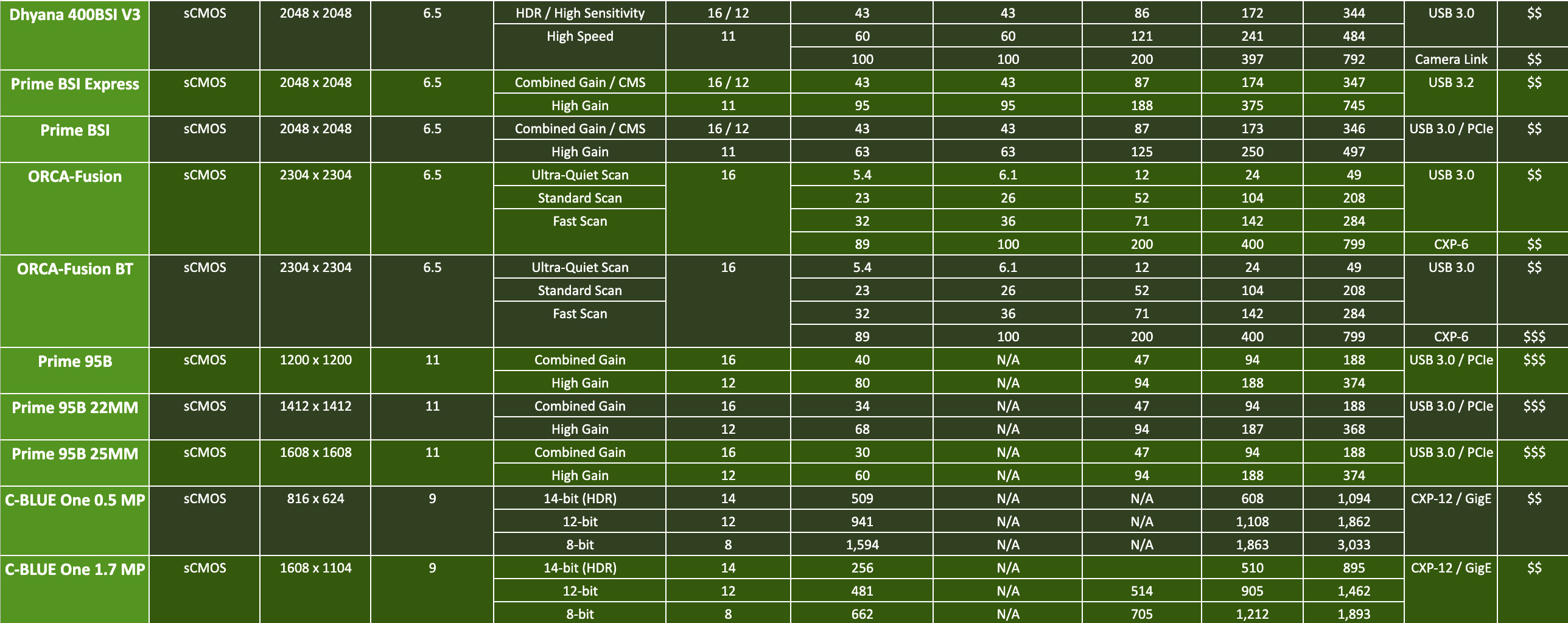Finding a camera for your scientific imaging application is not an easy task, especially when considering the various technologies, manufacturers, camera models, and features. The constant release of new models and technologies makes it even harder to keep up and choose the camera that best fits your needs and budget. This scientific camera buyer’s guide aims to make this process a little easier.
In the following, we classify a list of about 30 scientific cameras that Axiom Optics offers. This list represents the scientific cameras available on the market as it includes well-known SPAD, qCMOS, sCMOS, CMOS, CCD, and intensified cameras.
I. Spectral Range
The first question to ask yourself is: Which spectral range (wavelength range or energy range) is relevant to my application?
Most of the cameras discussed further down are sensitive to the visible spectrum, typically from 400 nm to 750 nm (sensors made of silicon), but some have enhanced sensitivity in the UV (ultraviolet) from 200 nm to 400 nm or in the NIR (near-infrared) from 750 nm to 1,000 nm.
Wavelengths above 1,000 nm are considered Infrared. Axiom Optics also offers a wide range of cameras that operate in the SWIR, MWIR, or LWIR spectral ranges, but those cameras are not discussed below. You can access more information and discover infrared scientific imaging applications here.
Axiom Optics also offers VUV, EUV, and x-ray CCD cameras, corresponding to wavelengths below 100 nm and down to 0.1 nm or, when expressed as photon energy, between 10 eV and 10 keV. These CCD cameras fall under the scientific cameras umbrella, but we will not include them here for the sake of simplicity.
TO SUMMARIZE:


II. Speed: Exposure Time / Frame Rate / Shutter
The second important criterion to consider is your temporal requirements. Ask yourself: What temporal resolution do I need?
- Do I need long exposure times? Do I specifically need to expose the camera for more than a few seconds, possibly up to several minutes, to increase the signal-to-noise ratio as much as possible? In that case, you will need a cooled camera with low dark current specifications to reduce the dark current contribution as much as possible. → Please refer to section 1: Long exposure time cameras below for more information.
- Do I need high temporal resolution? Do I specifically need a high temporal resolution to detect or measure events happening very quickly, typically in the order of a few milliseconds to a few nanoseconds? In that case, you will need a camera that allows very short exposures and can acquire many images at a high frame rate. → Please refer to section 2: High frame rate cameras below for more information.
- Can I work within moderate exposure times? Am I fine working within the range of a few hundred milliseconds to a couple of seconds? If so, most of the cameras in our catalog will meet your needs, and you won’t need to opt for a high-end model, at least for this requirement.
1. Long exposure time scientific cameras
If you need a camera capable of acquiring photons for many seconds, you will need to pay special attention to the cooling and dark current specifications. Dark current refers to the current circulating in the chip even when no photons hit the camera. This is a thermal phenomenon resulting from electrons spontaneously generated in the silicon chip, which contribute to the overall noise (this noise contribution is called dark noise or shot noise). As a rule of thumb, dark current halves every 8-10°C. Below is a table comparing the scientific cameras we offer that are suitable for long-exposure imaging over 10 seconds (and up to several hours):

Note: “$” = <$10,000 | “$$” = <$25,000 | “$$$” = <$40,000 | “$$$$” = >$40,000.
2. High frame rate scientific cameras
If your scientific imaging requires a very short exposure time and/or high frame rates, you can choose one of the cameras listed below. Most of these cameras can achieve higher frame rates by digitally cropping the size of the sensor and acquiring light only from pixels within this cropped region. Most cameras also feature several different readout modes, each with a specific frame rate. Typically, the slower the frame rate, the lower the readout noise, allowing users to choose between speed and sensitivity.
- Section a) Very high-speed CMOS cameras (100+ fps): Cameras capable of reaching frame rates above 100 fps at full frame.
- Section b) High-speed CMOS cameras (30–100 fps): Cameras with frame rates between 30 fps and 100 fps at full frame.
- Section c) Standard speed CMOS cameras (up to 30 fps): Cameras with frame rates of 30 fps or below at full frame.
- Section d) Global shutter vs. rolling shutter: Explains the differences, advantages, and drawbacks of global and rolling shutters.
- Section e) A fair comparison of frame rates: Compares frame rates across different resolutions and readout modes.
a) Very high-speed CMOS , SCMOS and SPADs (100+ fps)
In this first table, we are comparing cameras capable of reaching frame rates above 100 fps at full frame:

Note: “$” = <$10,000 | “$$” = <$25,000 | “$$$” = <$40,000 | “$$$$” = >$40,000.
b) High-speed CMOS and sCMOS (30 – 100 fps)
In this second table, we are comparing cameras capable of reaching frame rates above 30 fps and up to 100 fps at full frame:

Note: “$” = <$10,000 | “$$” = <$25,000 | “$$$” = <$40,000 | “$$$$” = >$40,000.
c) Standard speed CMOS (up to 30- fps)
In this third table, we are comparing cameras capable of reaching frame rates of 30 fps or below at full frame:

Note: “$” = <$10,000 | “$$” = <$25,000 | “$$$” = <$40,000 | “$$$$” = >$40,000.
d) Global shutter vs. rolling shutter
In some scientific imaging applications, the shutter type of the camera is an important specification. There are two options: global shutter or rolling shutter. In a global shutter, the entire pixel array is exposed to light at the same time, whereas in a rolling-shutter architecture, the light is captured line-by-line, typically from the top to the bottom of the sensor, creating a time lag between the top and the bottom of the image. When imaging a fast-moving sample (dynamic in the same range as the readout speed of the camera) covering a large portion of the field of view, a rolling-shutter camera will be subject to motion artifacts. However, in some applications, the rolling shutter can be used to an advantage. For instance, in light-sheet fluorescence microscopy, the rolling shutter can be synchronized with the beam of light being swept across the field of view to significantly increase the SNR.
All CCD cameras have a global shutter, and most of the CMOS cameras in this guide are rolling-shutter cameras, except for the following models: Moment (Teledyne Photometrics), Retiga E7 (Teledyne Photometrics), C-BLUE One 0.5MP, C-BLUE One 1.7MP, C-BLUE One 7.1MP, C-BLUE One UV (First Light Imaging / Oxford Instruments), HiCAM Fluo 1000, and HiCAM Fluo 2000 (Lambert Instruments).
e) A fair(er) comparison of frame rates
As mentioned earlier, most cameras can achieve higher frame rate by cropping the field of view. In this section, we are comparing the frame rates of all the cameras above and their different readout modes at specific resolutions.



Note: “$” = <$10,000 | “$$” = <$25,000 | “$$$” = <$40,000 | “$$$$” = >$40,000.
f) Time-gated cameras
In some scientific imaging applications, even a few-microsecond exposure time is not short enough to achieve the desired temporal resolution. In that case, we offer a few time-gated cameras that can achieve effectively shorter exposure times by using electronic gating as short as a few nanoseconds:
- The SPAD5122 can achieve gating durations as short as 6 ns, with increments as short as 17 ps.
- The TRICAM, HiCAM Fluo 1000 and HiCAM Fluo 2000 can achieve gating durations as short as 3 ns, with increments as short as 10 ps.
III. Sensitivity & Noise
This blog is about scientific cameras, which perform well in low-light conditions such as fluorescence microscopy and spectroscopy. To give a number, we consider low-light conditions to be applications where the camera receives a photon flux of 1 to 100 photons per pixel. However, not all cameras are the same. Some cameras are so sensitive that they are capable of detecting single-photon events. These cameras will be categorized as photon-counting cameras. Some cameras cannot detect single-photon events but are still extremely sensitive and perform well in a regime of 5 photons (or more) per pixel. These cameras will be categorized as extremely sensitive cameras. Lastly, other cameras will only perform well when receiving above 10 photons per pixel. These cameras will be categorized as very sensitive cameras.
1. Signal-to-Noise Ratio (SNR)
Before digging into these cameras, we want to discuss a little more about what makes a camera sensitive. It comes down to two characteristics:
- The capability of the camera to convert incoming photons into electrons: this is called quantum efficiency, and it is wavelength-dependent.
- The capability of the camera to read and detect those electrons coming from the signal amid the electrons generated by different noise sources: readout noise, dark noise, and photon noise are the three most common sources of noise.
The signal-to-noise ratio (SNR) is a good way to describe and compare the sensitivity of different cameras for a certain number of photons (P) reaching one pixel. The SNR takes into account both the quantum efficiency (QE) and the different noise characteristics. Here is the formula:

In the next sections, we are making two assumptions:
- The dark noise contribution is negligible, because the integration time is very short or the frame rate is very high, or because the dark current itself is very low.
- The optical system is optimized to match the pixel size of the camera, so we can compare cameras with different pixel sizes without this having any impact.
2. Photon – Counting Cameras
In this first table, we are comparing cameras with a SNR at two photons per pixel above 1.20:

Note: “$” = <$10,000 | “$$” = <$25,000 | “$$$” = <$40,000 | “$$$$” = >$40,000.
3. Extremely Sensitive Cameras
In this second table, we are comparing cameras with a SNR at two photons per pixel below 1.20, but above 1.80 at five photons per pixel:

Note: “$” = <$10,000 | “$$” = <$25,000 | “$$$” = <$40,000 | “$$$$” = >$40,000.
4. Very Sensitive Cameras
In this third table, we are comparing cameras with a SNR at five photons per pixel below 1.80, but above 2.00 at 10 photons per pixel:

*The Retiga E7 in Full Well readout mode is the only scientific camera and only readout mode with a SNR at 10 photons below 2. For the sake of exhaustivity we decided to include that mode here.
Note: “$” = <$10,000 | “$$” = <$25,000 | “$$$” = <$40,000 | “$$$$” = >$40,000.
To view our full range of cameras for your scientific imaging needs, click here to download our camera catalog.
